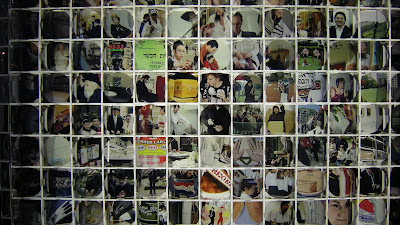One of the highlights for me was a temporary exhibit regarding The American Colony. The colony was established in 1881 when Horatio Spafford and his wife, Anna Larsen moved to Jerusalem. They had been Orthodox Presbyterians in Chicago and suffered a horrible fate of losing their children to illness and a boating accident. The Chicago church decided that God was punishing the family and they were ostracized--thus their move to Jerusalem. They established the American Colony whose mission was service to all. The colony offered hospitality and assistance to anyone requesting help and did so without any attempt to convert. This attitude won the confidence of Muslim, Jews, and Christians alike. Over time, other church members, particularly from Sweden traveled to and joined the colony.
In 1898 the colony invested in a camera and several colonists took over the role of photographer. Between 1898 - 1934 they took 5000 pictures covering the land of Palestine; they would sell the photographs to visiting tourists. They utilized lantern slides which are images on a glass plate made by a negative and then tinted and colored by hand. The tinting is so precise that the brush utilized consisted of one single hair. The following are but a few of my favorites:
Lantern slides and their projector.
A street in Nazareth.
A street in Nazareth.
The Tomb of Lazarus.
The Wailing Wall in Jerusalem.
Within the museum as one wanders via the Ashkenazi Synagogue Complexes...
A special chair for circumcision...
A Torah from the 12th Century..
Shabbetai Zevi: A false messiah. To me this was very interesting to read and learn about. In 1648, at the young age of 22, Mr. Zevi proclaimed himself to be the messiah. Over the next 18 years he had his ups and downs between his followers and detractors. Ultimately, in 1666, he resigned his self-proclaimed post and much to the chagrin of his many followers, he converted to Islam.
A beautiful carving....
Since before 1492, to escape persecution and the Spanish Inquisition, many Jews fled both Spain and Portugal and made their way to the Netherlands where they were allowed religious freedom and opportunities to integrate into the culture. WWII put an end to that prosperity. Within the Jewish communities around the country, there was much disagreement and controversy as to whether they should willingly comply with the registration required by the Nazis or fight those orders. Jewish leadership in Amsterdam asserted their hope that through compliance and cooperation with the Germans less harm might befall them. They were wrong. Of the Jews in Holland, 3/4 were deported to extermination camps where they would be tortured and murdered, via the German-run Westerbork transit camp. This camp was in the northeastern region of the Netherlands. From there they were sent to other German camps, most tragically Auschwitz in Poland, where they were murdered.After the war, those Jews who survived found it difficult to return to the Netherlands. With the establishment of the State of Israel in 1948, many left and relocated in Israel.
Today, 43,000 live in the Netherland; over 50% reside in Amsterdam. 57% of Dutch Jews state that they do not practice any sort of religion.
Some scenes of a more current life.












No comments:
Post a Comment